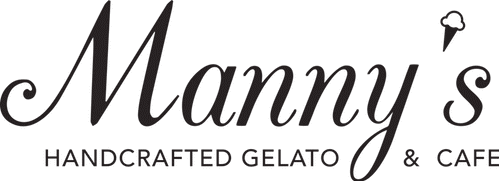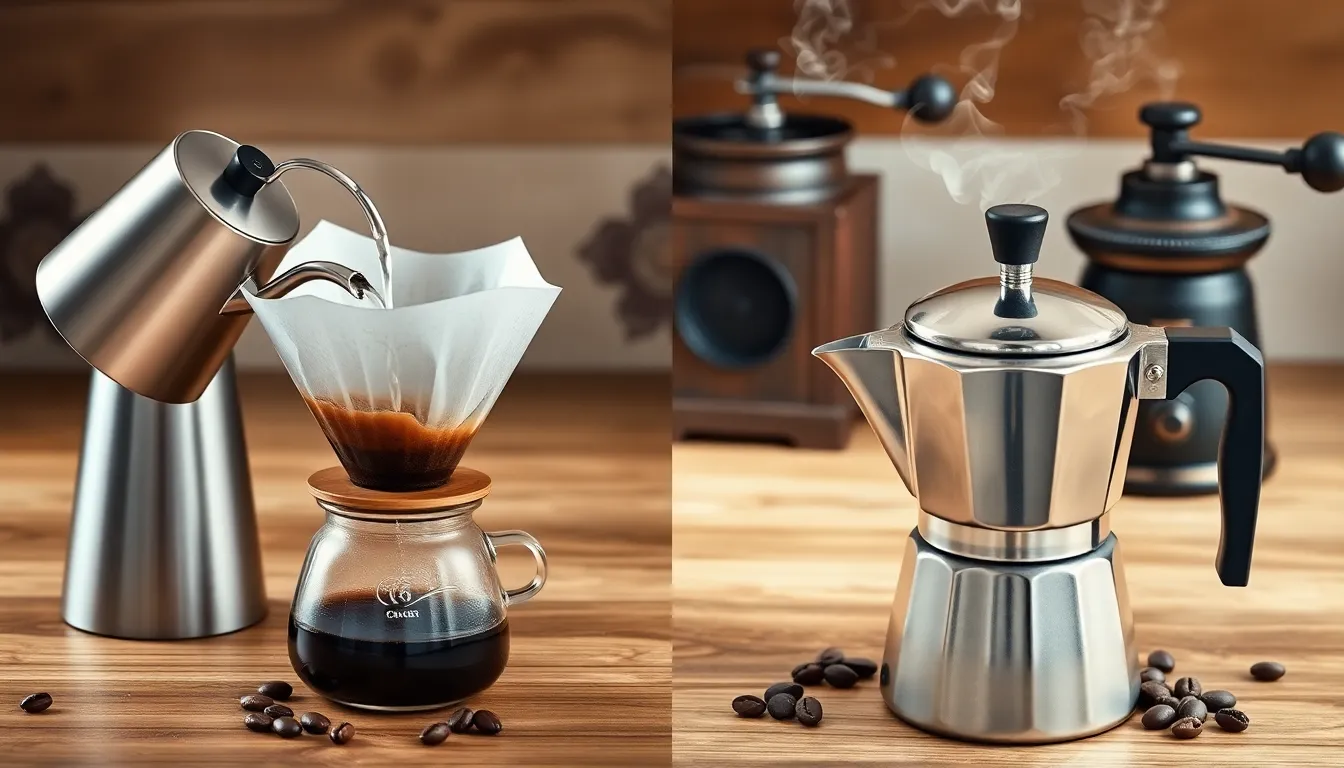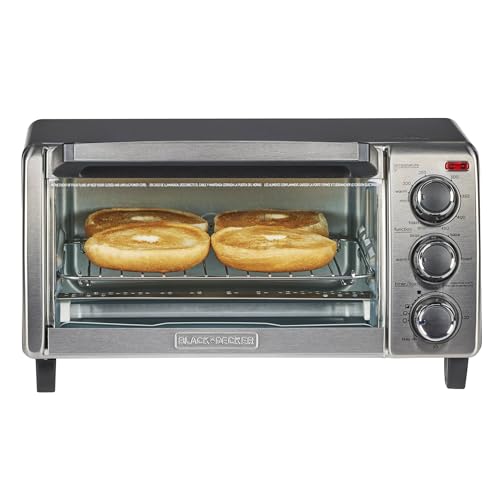When it comes to brewing coffee at home, the pour over and Moka pot methods represent two distinct approaches to extracting those precious flavors from your beans. Both methods have passionate followers, yet they create notably different coffee experiences that might align better with your exact taste preferences.
In this comparison, you’ll discover how the slow, methodical pour over process creates a clean, nuanced cup that highlights subtle flavor notes, while the Moka pot delivers a rich, intense brew that approaches espresso-like strength. We’ll explore the key differences in flavor profiles, brewing techniques, and equipment requirements to help you decide which method deserves a spot on your kitchen counter.
The Fundamentals of Coffee Brewing Methods
Coffee brewing methods vary widely, each creating distinct flavor profiles and experiences. Understanding the basic principles behind different techniques helps you select the perfect brewing method for your taste preferences.
Extraction Process
Extraction forms the foundation of all coffee brewing. It’s the process where hot water dissolves soluble compounds from coffee grounds, creating the beverage we enjoy. Temperature, contact time, and grind size significantly impact extraction quality. Pour over brewing offers precise control over these variables, allowing water to flow through grounds at a consistent rate. Moka pots use pressure and higher temperatures to force water through coffee, resulting in stronger extraction of oils and compounds.
Water Temperature and Quality
Water temperature plays a crucial role in proper extraction. The ideal range falls between 195°F and 205°F (90-96°C) for most brewing methods. Pour over techniques benefit from precise temperature control using specialized kettles. Moka pots naturally reach higher temperatures as water heats in the bottom chamber, often approaching 212°F (100°C). Water quality equally affects your final cup—filtered water produces cleaner flavors in pour over brewing, while the intense nature of Moka pot coffee sometimes masks subtle water quality differences.
Grind Size Considerations
Grind size directly affects extraction rate and flavor development. Pour over methods typically require medium to medium-fine grinds, similar to table salt consistency. This grind allows proper water flow while extracting balanced flavors over a 2-4 minute brew time. Moka pots function best with medium grinds—finer than pour over but coarser than espresso. Using too fine a grind in Moka pots often creates bitter, over-extracted coffee or clogs the filter basket.
Brewing Time and Flow Rate
Brewing duration significantly impacts flavor development. Pour over methods typically take 2-4 minutes, with baristas controlling flow rate through pouring technique. This precise timing extracts desired compounds while leaving behind excessive bitterness. Moka pots operate on a different principle, completing extraction in 1-2 minutes as pressurized water moves through the coffee grounds. The shorter brewing time combined with pressure creates the Moka pot’s characteristic intensity.
Pour Over Coffee: An Elegant Precision
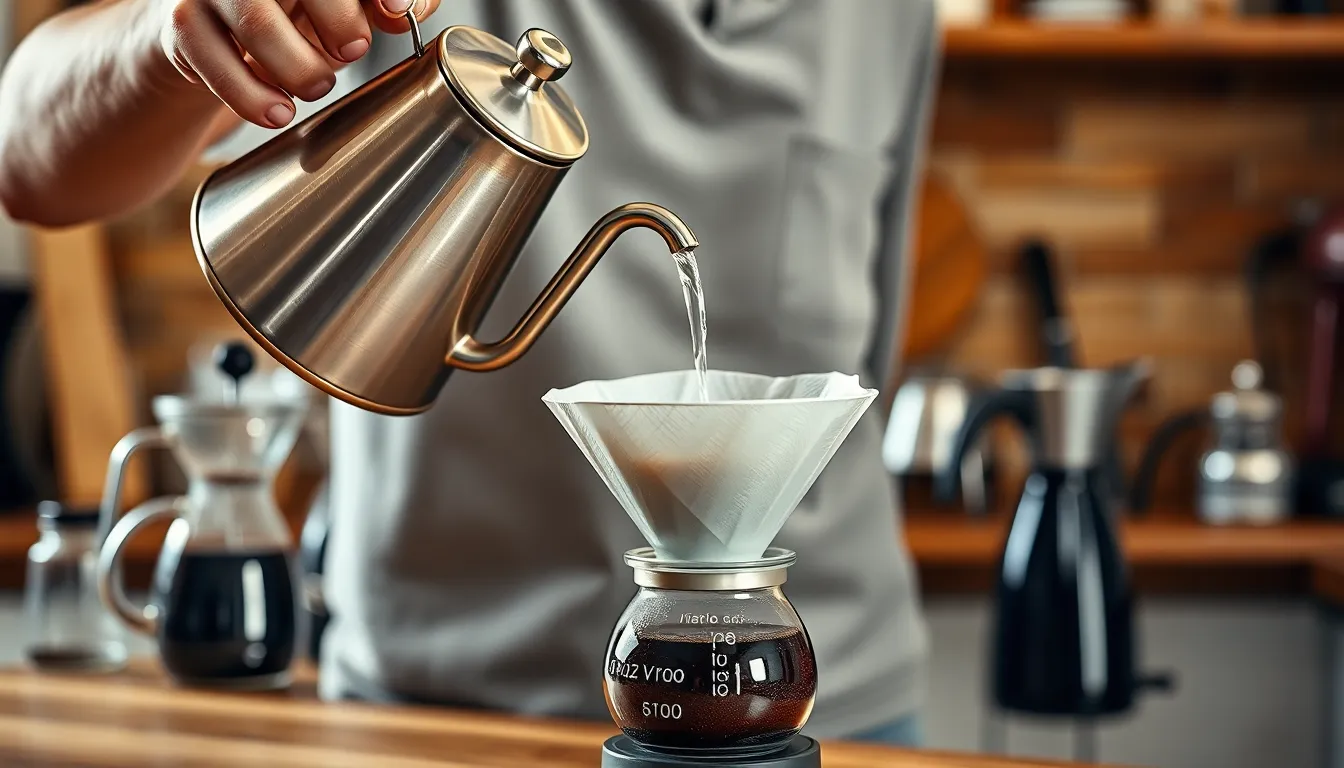
Pour over coffee represents the art of manual brewing at its finest. This method delivers exceptional clarity of flavor and offers complete control over each brewing variable, making it a favorite among coffee enthusiasts and professionals alike.
How Pour Over Works
Pour over brewing extracts coffee flavors through a simple yet refined process. Hot water flows through coffee grounds contained in a filter, allowing gravity to pull the water through at a controlled rate. The steady, even saturation of grounds enables optimal extraction of aromatic compounds and soluble solids. Unlike immersion methods, pour over creates a clean cup by constantly introducing fresh water to the grounds while the brewed coffee immediately separates through the filter. This continuous flow prevents over-extraction and highlights the coffee’s vibrant acidity and complex flavor notes. The process typically takes 2-4 minutes, giving you time to appreciate the brewing ritual while precisely controlling the extraction.
Equipment Needed for Pour Over
Creating the perfect pour over setup requires several essential components. A dripper or cone (like Hario V60, Chemex, or Kalita Wave) forms the foundation of your brewing station. Each dripper design influences flow rate and extraction patterns differently – V60’s spiral ridges encourage even extraction, while Chemex’s thicker filters remove more oils. You’ll need appropriate filters, either paper (for cleaner cups) or metal (for fuller body and less waste). A gooseneck kettle provides the precise pouring control necessary for even extraction. The narrow spout allows you to direct water exactly where needed at a consistent rate. A scale helps measure coffee (18-22g per 12oz cup) and water amounts for repeatable results. Medium to medium-fine ground coffee works best for pour over, resembling the texture of granulated sugar. Finally, a timer ensures you maintain the proper brew duration for optimal flavor development.
Moka Pot: The Stovetop Classic
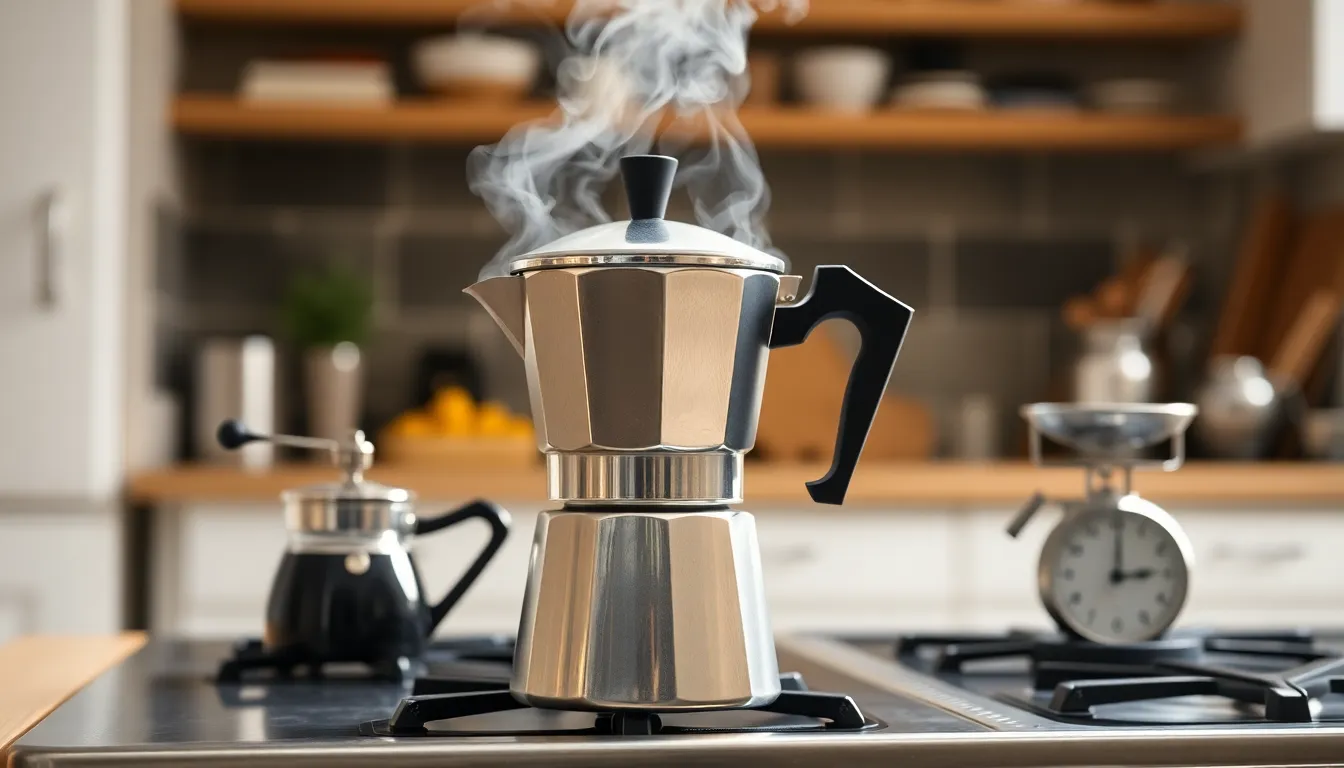
The Moka pot stands as an iconic stovetop coffee maker that creates a strong, intense brew through steam pressure. This three-chambered aluminum or stainless steel device, invented in Italy in 1933, produces coffee that bridges the gap between drip coffee and espresso with its rich mouthfeel and robust flavor profile.
How Moka Pot Works
The Moka pot operates through a simple yet ingenious pressure-brewing system. Water in the bottom chamber boils when placed on a heat source, creating steam pressure that forces the hot water upward through the coffee grounds. The water travels through the middle basket containing finely ground coffee, extracting the flavors, oils, and compounds along the way. Brewed coffee then collects in the upper chamber, ready to be served. This entire brewing process takes approximately 5 minutes, including some cooling time after removing from heat. The resulting coffee features a heavier body and more concentrated flavor than pour-over methods, though with less pressure than commercial espresso machines.
Equipment Needed for Moka Pot
Setting up for Moka pot brewing requires minimal equipment compared to other brewing methods. You’ll need the Moka pot itself, typically available in various sizes from 1-cup to 12-cup models. Medium-fine to fine ground coffee works best in Moka pots – slightly finer than what you’d use for pour-over but not as fine as espresso grind. A heat source such as a stovetop (gas, electric, or induction depending on your pot’s material) is essential for brewing. While not strictly necessary, a grinder gives you control over the grind size for optimal extraction, and a digital scale helps maintain consistent coffee-to-water ratios. Many Moka pot enthusiasts also keep a small towel or oven mitt handy for handling the hot metal pot after brewing.
Flavor Profile Comparison
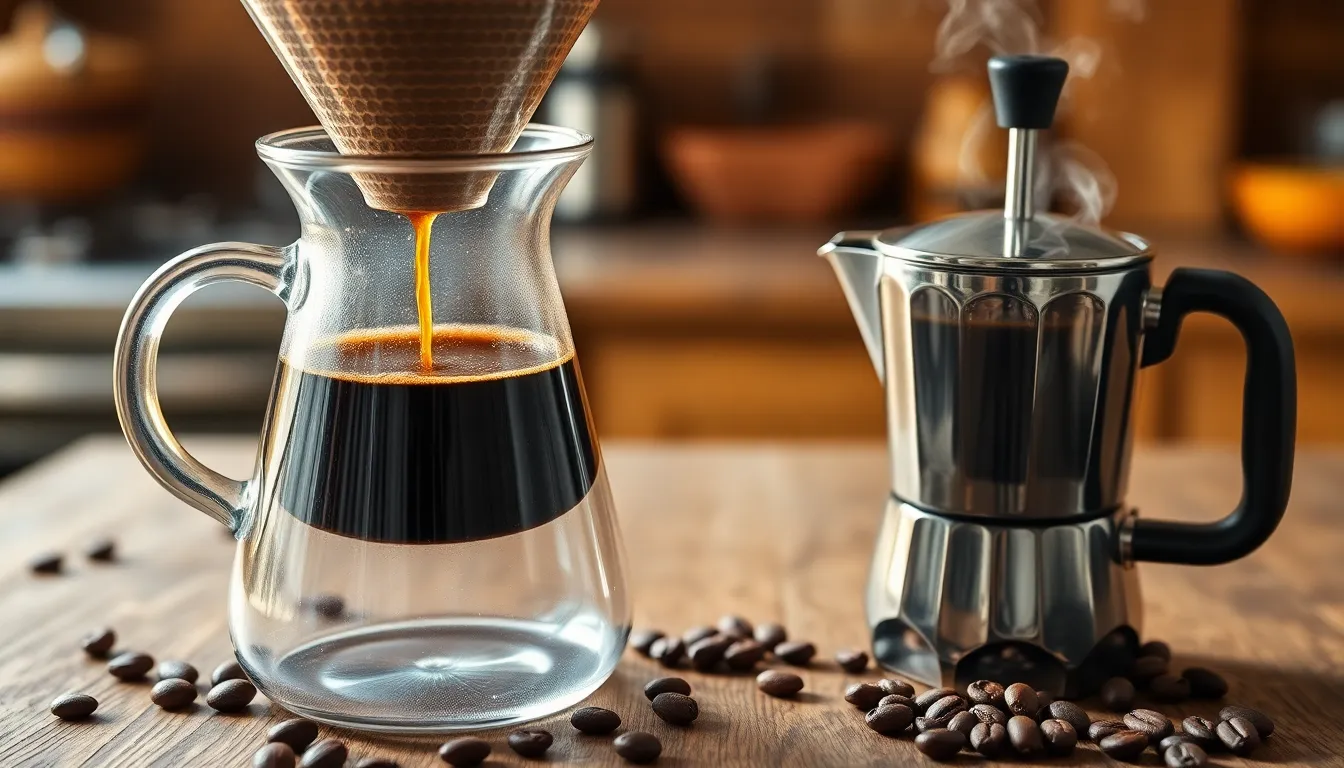
The flavor profiles of pour over and Moka pot coffee differ dramatically due to their distinct brewing mechanisms. Pour over delivers a clean, nuanced cup while Moka pot produces a bold, concentrated brew reminiscent of espresso. Let’s explore the distinctive characteristics of each method.
Pour Over Flavor Characteristics
Pour over coffee creates a clean, smooth, and complex flavor profile with a delicate mouthfeel. Its gravity-based extraction process allows water to flow slowly through the grounds, highlighting subtle flavor notes, bright acidity, and aromatic complexity that might otherwise be masked in pressure brewing systems. This brewing method produces significantly less bitterness compared to other techniques, resulting in a clearer representation of the bean’s natural qualities. Medium to light roast beans paired with a medium-coarse grind complement pour over brewing perfectly, improving the clarity and complexity in your cup. Many coffee enthusiasts appreciate pour over for its ability to showcase the unique terroir and processing methods of specialty coffees.
Moka Pot Flavor Characteristics
Moka pot coffee delivers a strong, robust, and full-bodied flavor with pronounced intensity and a heavier mouthfeel. The steam pressure brewing process forces hot water through finely ground coffee, extracting more oils and solids than gravity methods, creating a concentrated taste profile that’s often compared to espresso. Darker roasts typically perform exceptionally well in Moka pots, as the brewing method accentuates their rich, deep flavor characteristics and enhances their natural boldness. Though lacking the crema of true espresso, Moka pot coffee provides substantially stronger and thicker results than pour over brewing. The resulting cup offers a distinctive sharpness and intensity that coffee lovers seeking a powerful morning brew particularly enjoy.
Brewing Time and Convenience
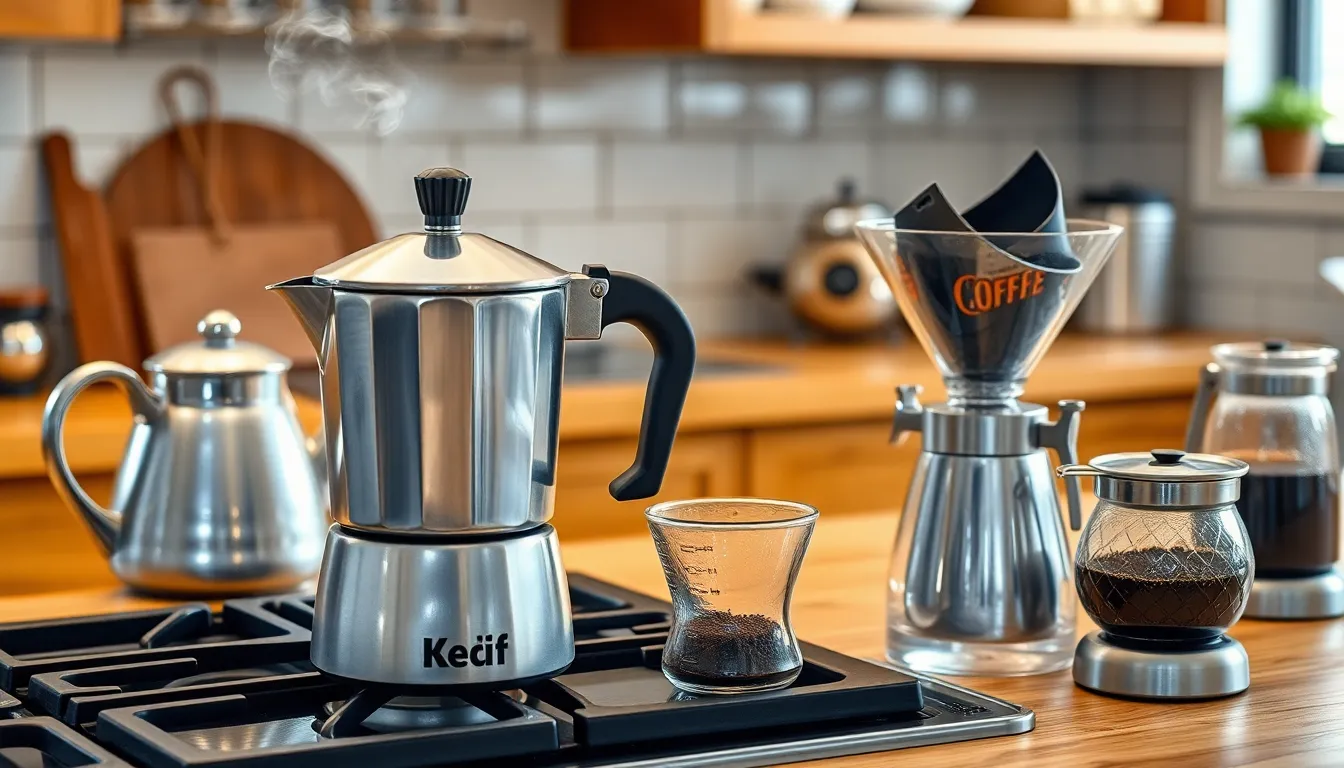
Time investment and hands-on effort play crucial roles when choosing between pour over and Moka pot brewing methods. Each technique offers distinct advantages in terms of convenience and time commitment.
Moka Pot Brewing Process
Moka pots deliver a relatively straightforward brewing experience that takes 5-10 minutes from start to finish. The actual brewing occurs in just 3-5 minutes once you’ve placed the assembled pot on the stove. This method requires minimal hands-on attention during the brewing phase, as the steam pressure automatically forces water through the coffee grounds. You’ll simply need to:
- Fill the bottom chamber with water
- Add ground coffee to the filter basket
- Assemble the pot
- Place it on your heat source
- Wait for the brewing to complete
The semi-automated nature makes Moka pots particularly appealing for busy mornings when you can’t dedicate full attention to your coffee brewing routine.
Pour Over Time Requirements
Pour over brewing involves a more active, hands-on approach. While the extraction process itself takes approximately 3-4 minutes, the entire procedure—including setup, preheating equipment, and cleanup—typically requires 5-10 minutes total. This method demands your continuous involvement throughout the brewing process as you:
- Preheat your brewer and kettle
- Measure and grind your coffee
- Control the water flow with exact pouring techniques
- Monitor the timing of each pour
- Clean up the filter and equipment afterward
The precision required for pour over brewing makes it less convenient for multitasking but offers greater control over the final result.
Equipment Considerations
Equipment needs further differentiate these brewing methods in terms of convenience:
| Method | Essential Equipment | Optional Equipment | Durability |
|---|---|---|---|
| Moka Pot | Moka pot, heat source | Scale, grinder | Highly durable, metal construction |
| Pour Over | Dripper, filters, gooseneck kettle | Scale, timer, thermometer | Often fragile (ceramic/glass components) |
Moka pots feature a simpler equipment setup, requiring just the pot itself and a heat source. Pour over brewing typically demands more specialized tools, particularly a gooseneck kettle for precision pouring and either disposable or reusable filters.
Daily Practicality
The practical convenience of each method largely depends on your morning routine and coffee preferences. Moka pots offer a “set and monitor” approach that allows for some multitasking during brewing. Pour over methods require your dedicated attention throughout the process but provide exceptional control over extraction variables.
Both methods eventually take similar amounts of total time (5-10 minutes), but the distribution of active versus passive time differs significantly. Your choice might depend on whether you prefer a more automated brewing experience or enjoy the meditative ritual of manually controlling each aspect of the extraction process.
Cost Considerations
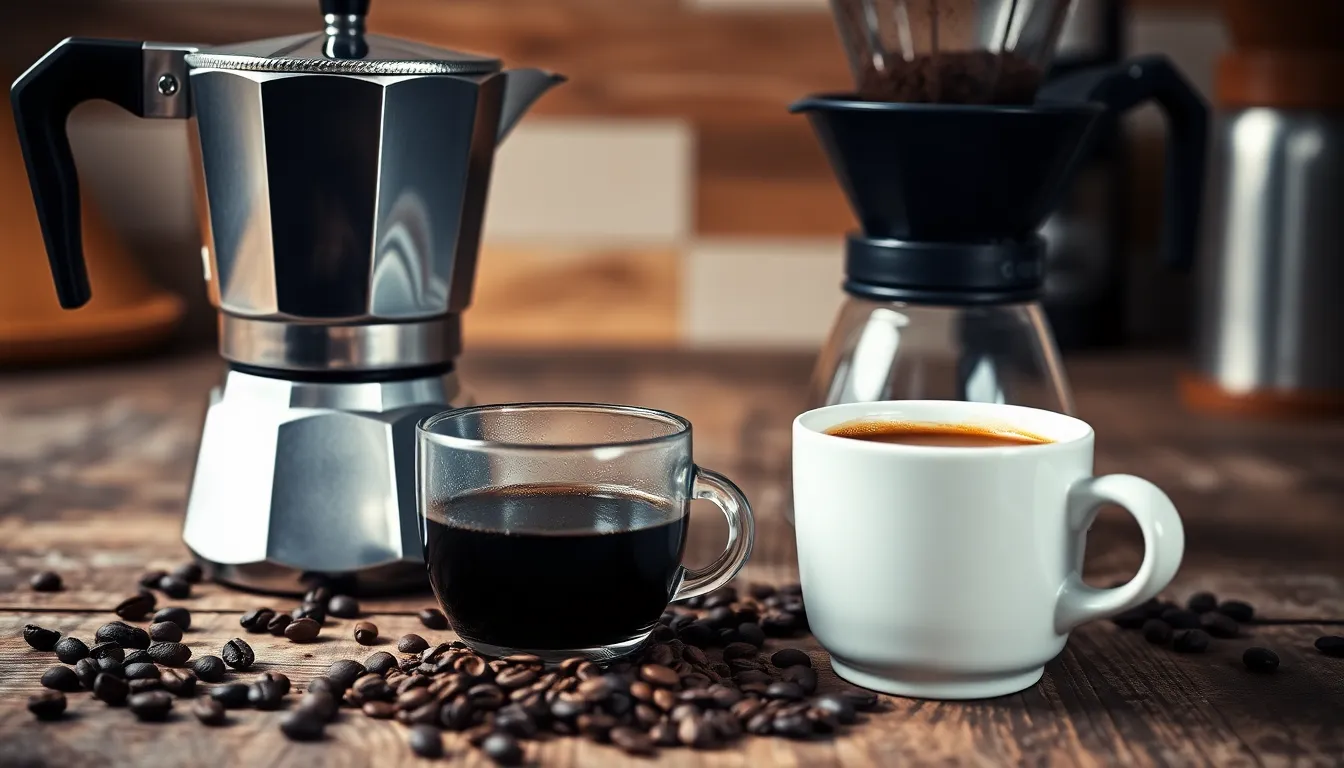
Initial Purchase Cost
Moka pots and pour-over coffee makers differ significantly in their upfront investment. Pour-over devices offer more budget-friendly entry points, with single-serve options starting as low as $8 and ranging up to $30. Carafe-style models like the popular Chemex command higher prices, typically $30 to $100+, with a standard six-cup Chemex priced around $50. Moka pots generally start at a higher price point, ranging from $20 to $100 depending on brand and capacity. A classic three-cup Bialetti Moka pot costs approximately $30-$40, while larger nine or eighteen-cup versions can reach $50 to $75+.
Recurring and Additional Costs
The long-term economics of these brewing methods reveal important differences. Moka pots excel in minimizing ongoing expenses since they don’t require paper filters or disposable components. Their metal construction features replaceable parts, creating an eco-friendly and cost-effective option over time. Pour-over methods typically involve continuing costs for paper filters, adding about 2 to 8 cents per brew. Though reusable metal filters exist for pour-over systems, many coffee enthusiasts prefer the clean taste that comes from paper filters, making this a recurring expense to consider in your budget.
Durability and Lifespan
Your investment’s longevity varies between these brewing options. Moka pots feature predominantly metal construction that withstands years of use, with gaskets and other components that can be replaced when worn. These sturdy brewers require thorough cleaning due to their multiple parts but reward proper maintenance with exceptional durability. Pour-over makers vary significantly in their resilience based on material construction. Glass and metal models offer good durability and recyclability, while ceramic versions, though attractive, tend to be more fragile and less environmentally friendly if broken.
| Feature | Moka Pot | Pour-over |
|---|---|---|
| Price Range | $20–$100 | $8–$100+ |
| Recurring Cost | Minimal (no filters needed) | Paper filters add ongoing cost |
| Durability | Metal, replaceable parts, durable | Glass/metal durable; ceramic fragile |
| Eco-friendliness | High (no single-use waste) | Variable; reusable filters can reduce waste |
Pour-over systems offer lower barriers to entry with their affordable starting prices, making them attractive for coffee beginners exploring manual brewing. Moka pots represent a slightly higher initial investment but eliminate the ongoing filter expenses, potentially saving money for daily coffee drinkers over the long term.
Which Method Is Right for You?
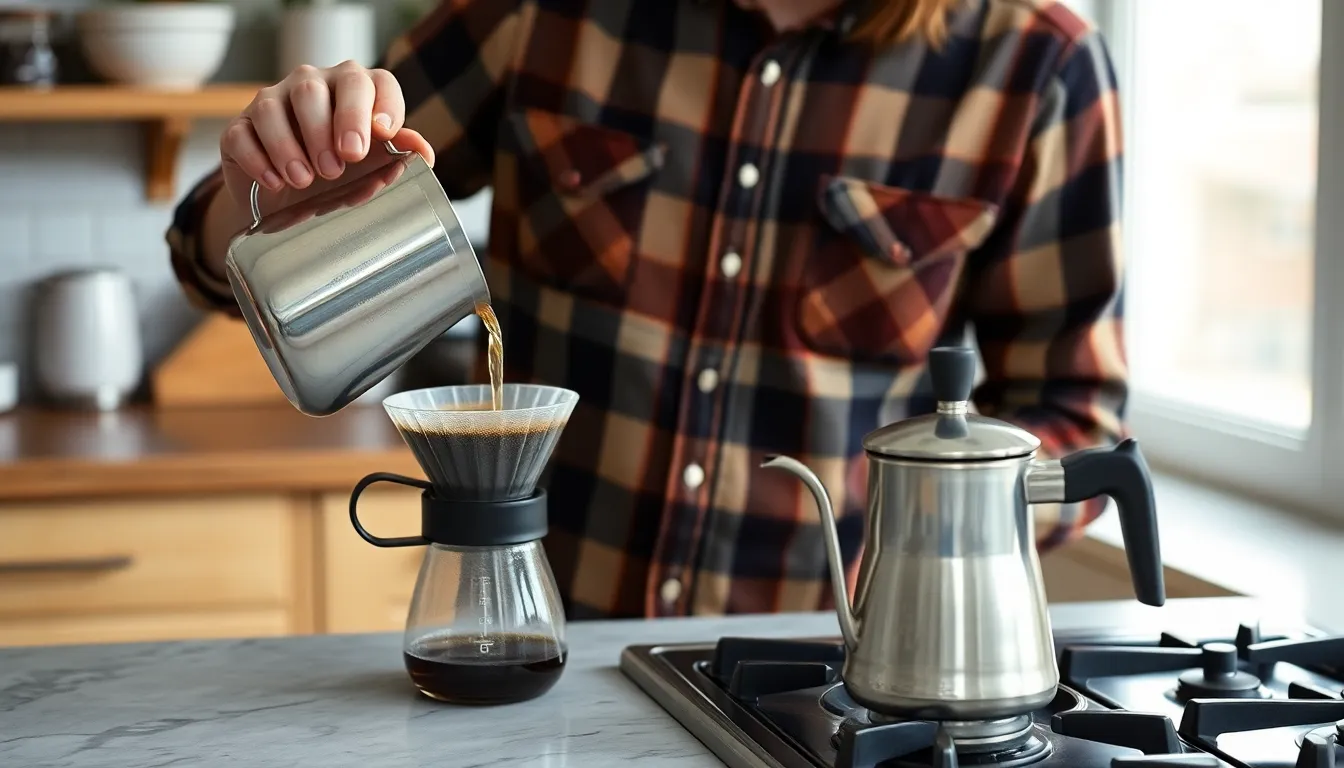
Pour over brewing offers a clean, delicate cup with pronounced flavor nuances and acidity. You’ll appreciate pour over if you enjoy lighter coffee with distinct flavor notes and prefer having precise control over brewing variables. Coffee enthusiasts who value the meditative ritual of manual brewing often gravitate toward this method. Pour over excels with lighter to medium roasts, revealing their complex floral and fruity notes through its meticulous extraction process.
Moka pot delivers a bold, intense coffee experience with minimal effort. You’ll find this method ideal if you crave a strong, espresso-like brew without investing in an expensive espresso machine. Moka pots produce coffee approximately three times stronger than pour over methods, featuring a heavier mouthfeel and more robust flavor profile. This brewing style particularly complements darker roasts, improving their rich, chocolatey characteristics.
Consider your daily routine when choosing between these methods. Moka pots require less active attention during brewing, making them suitable for busy mornings when you need strong coffee without constant monitoring. Pour over demands your presence throughout the brewing process, appealing to those who enjoy the create of coffee making and have time to dedicate to the perfect cup.
Your equipment preferences also factor into this decision. Pour over setups typically involve more specialized equipment like gooseneck kettles and filters, while Moka pots need only the pot itself and a heat source. The straightforward design of Moka pots makes them excellent travel companions, whereas pour over travel kits tend to be more complex.
Conclusion
Choosing between pour over and Moka pot eventually depends on your personal coffee preferences. If you value clarity of flavor nuanced acidity and the meditative ritual of manual brewing pour over might be your perfect match. Its light body and bright character showcase specialty coffee’s distinct notes beautifully.
For those craving a stronger bolder coffee experience with rich body and minimal fuss the Moka pot delivers impressive results. Its espresso-like intensity and straightforward brewing process make it ideal for coffee lovers who appreciate robustness over subtlety.
Both methods offer affordable entry points into specialty coffee brewing at home. Your choice might come down to whether you prefer the hands-on precision of pour over or the set-it-and-go simplicity of the Moka pot. Whichever you select you’ll enjoy a important upgrade from ordinary drip coffee.
Frequently Asked Questions
What’s the main difference between pour over and Moka pot coffee?
Pour over coffee produces a clean, nuanced cup that highlights subtle flavors with a delicate mouthfeel, ideal for light to medium roasts. Moka pot creates a rich, intense brew similar to espresso with a heavier body and concentrated flavor, better suited for medium to dark roasts. Pour over offers more precise control, while Moka pot uses pressure brewing for stronger extraction.
Which brewing method is more convenient for daily use?
The Moka pot is generally more convenient, requiring just 5-10 minutes with minimal hands-on attention during brewing. Pour over methods demand more active involvement throughout the 5-10 minute process, requiring continuous pouring and monitoring. If you prioritize convenience and simplicity, the Moka pot has an advantage.
What equipment do I need for pour over brewing?
Pour over brewing requires a pour over dripper (like V60, Chemex, or Kalita Wave), paper filters, a gooseneck kettle for controlled pouring, a scale for precise measurements, and a timer. A quality burr grinder is also recommended for consistent grind size. While more equipment-intensive, this setup allows for precise control over brewing variables.
How much does each brewing method cost?
Pour over devices have a lower initial cost (starting around $8-$30), but require ongoing purchases of paper filters. Moka pots range from $20-$100 depending on size and materials, but have minimal recurring costs since they don’t use disposable filters. Moka pots tend to be more durable with their all-metal construction and replaceable parts.
What’s the ideal water temperature for coffee brewing?
The ideal water temperature for coffee brewing is between 195°F and 205°F (90-96°C). This range ensures optimal extraction of coffee compounds without burning the grounds. Pour over methods allow precise temperature control when using a variable temperature kettle, while Moka pots naturally reach appropriate temperatures during the brewing process.
Which grind size works best for each method?
Pour over methods typically require medium to medium-fine grind (similar to table salt), allowing for proper extraction during the 2-4 minute brewing process. Moka pots work best with a medium grind—finer than pour over but coarser than espresso—to prevent clogging while still allowing proper extraction under pressure.
How long does each brewing method take?
Pour over brewing takes approximately 2-4 minutes for the actual extraction, with total preparation time of 5-10 minutes including setup and cleanup. Moka pot brewing takes about 5 minutes for the brewing process once assembled, with minimal preparation and cleanup time. Both methods are relatively quick compared to other brewing techniques.
Which method is better for bringing out coffee’s flavor notes?
Pour over excels at highlighting the subtle flavor notes in specialty coffees, particularly floral, fruity, and acidic qualities found in lighter roasts. The Moka pot brings out rich, bold flavors with pronounced bitterness and intensity, enhancing chocolate, nutty, and caramel notes in darker roasts. Your preference for delicate versus robust flavors should guide your choice.
Can I make multiple cups with these brewing methods?
Yes, both methods can make multiple cups. Moka pots come in various sizes (1-cup to 12-cup models) and brew all servings simultaneously. Pour over devices also range in size, with larger models like the Chemex capable of brewing up to 8 cups at once. For serving groups, larger Moka pots offer more convenience with less active brewing time.
Which method is better for beginners?
The Moka pot is generally more beginner-friendly due to its straightforward setup and less technical brewing process. Pour over methods require more technique, including precise pouring patterns and timing. However, pour over brewing can be more forgiving in terms of grind size adjustments, allowing beginners to experiment and improve their technique gradually.
